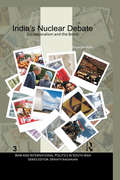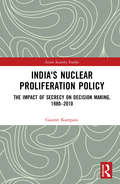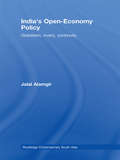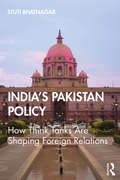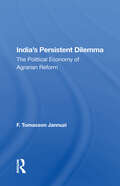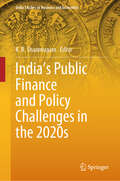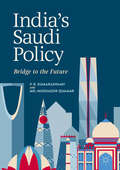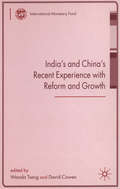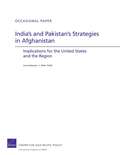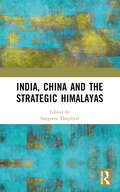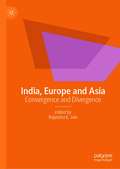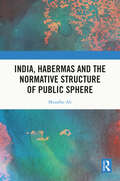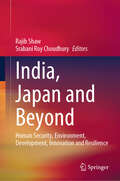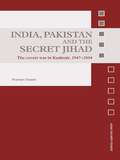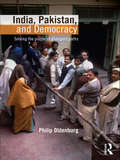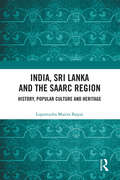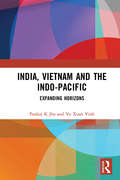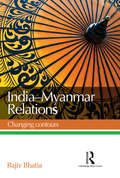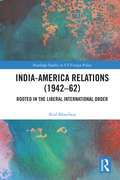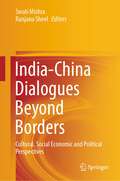- Table View
- List View
India's Nuclear Debate: Exceptionalism and the Bomb (War and International Politics in South Asia)
by Priyanjali MalikMaking the right-wing Bharatiya Janata Party’s nuclear tests in 1998 its starting point, this book examines how opinion amongst India’s ‘attentive’ public shifted from supporting nuclear abstinence to accepting — and even feeling a need for — a more assertive policy, by examining the complexities of the debate in India on nuclear policy in the 1990s. The study seeks to account for the shift in opinion by looking at the parallel processes of how nuclear policy became an important part of the public discourse in India, and what it came to symbolise for the country’s intelligentsia during this decade. It argues that the pressure on New Delhi in the early 1990s to fall in line with the non-proliferation regime, magnified by India’s declining global influence at the time, caused the issue to cease being one of defence, making it a focus of nationalist pride instead. The country’s nuclear programme thus emerged as a test of its ability to withstand external compulsions, guaranteeing not so much the sanctity of its borders as a certain political idea of it — that of a modern, scientific and, most importantly, ‘sovereign’ state able to defend its policies and set its goals.
India's Nuclear Proliferation Policy: The Impact of Secrecy on Decision Making, 1980–2010 (Asian Security Studies)
by Gaurav KampaniThis book examines India’s nuclear program, and it shows how secrecy inhibits learning in states and corrodes the capacity of decision-makers to generate optimal policy choices. Focusing on clandestine Indian nuclear proliferation during 1980–2010, the book argues that efficient decision-making is dependent on strongly established knowledge actors, high information turnover and the capacity of leaders to effectively monitor their agents. When secrecy concerns prevent states from institutionalizing these processes, leaders tend to rely more on heuristics and less on rational thought processes in choices involving matters of great political uncertainty and technical complexity. Conversely, decision-making improves as secrecy declines and policy choices become subject to higher levels of scrutiny and contestation. The arguments in this book draw on compelling evidence gathered from interviews conducted by the author, with interviewees including individuals who were involved in nuclear planning in India from 1980 to 2010, such as former cabinet and defence secretaries, the principal secretary to the prime minister, national security advisors, secretaries to the department of atomic energy, military chiefs of staff and their principal staff officers, and commanders of India’s strategic (nuclear) forces. This book will be of much interest to students of nuclear proliferation, Asian politics, strategic studies and International Relations.
India's Open-Economy Policy: Globalism, Rivalry, Continuity (Routledge Contemporary South Asia Series #Vol. 14)
by Jalal AlamgirThis book is the first major exploration of Indian political economy using a constructivist approach. Arguing that India’s open-economy policy was made, justified, and continued on the basis of the idea of openness more than its tangible effect, the book explains what sustained the idea of openness, what philosophy, interpretations of history, and international context gave it support, justification, and persuasive force. Drawing on a wide range of contemporary and historical sources, and going as far back as the 19th century, the author reconstructs how Indian policymakers have interpreted economic priorities, perceived success and failure, and evaluated the destiny of their nation. By the 1990s, their imperatives increasingly highlighted a sense of rivalry, especially with China, and globalism, a desire to play a strong role in world affairs. The book shows how a sense of nationalist urgency was created through globalism and rivalry, allowing policymakers to privilege international needs over domestic political demands, replace economic independence with interdependence as a priority, and ensure that the broad basis of India’s openness could not be challenged effectively even though certain policies faced severe opposition. This book will be of interest to those working on International Political Economy, Globalization, Economic History, Public Policy, and South Asian politics.
India's Pakistan Policy: How Think Tanks Are Shaping Foreign Relations
by Stuti BhatnagarThis book critically examines the role of think tanks as foreign policy actors. It looks at the origins and development of foreign policy think tanks in India and their changing relevance and position as agents within the policy-making process. The book uses a comparative framework and explores the research discourse of prominent Indian think tanks, particularly on the India–Pakistan dispute, and offers unique insights and perspectives on their research design and methodology. It draws attention to the policy discourse of think tanks during the Composite Dialogue peace process between India and Pakistan and the subsequent support from the government which further expanded their role. One of the first books to offer empirical analyses into the role of these organisations in India, this book highlights the relevance of and the crucial role that these institutions have played as non-state policy actors. Insightful and topical, this book will be of interest to researchers focused on international relations, foreign policy analysis and South Asian politics. It would also be a good resource for students interested in a theoretical understanding of foreign policy institutions in general and Indian foreign policy in particular.
India's Persistent Dilemma: The Political Economy Of Agrarian Reform
by F. Tomasson JannuziThis book shows that the failure of successive Indian governments to effect meaningful agrarian reforms has led to a political economy in rural India that is shaped, as it was prior to independence, largely by the interests of an elite minority of landholders. .
India's Public Finance and Policy Challenges in the 2020s (India Studies in Business and Economics)
by K. R. ShanmugamThis book extensively examines various contemporary public finance themes of India, namely fiscal policy and macro economy, public expenditure policy, tax policy, fiscal transfers policy, public debt policy and fiscal imbalance, and environment and climate finance policies. It has three to five chapters devoted to each of these broad themes, with the contributors being eminent economists from the region. While the topics are specific to Indian public finance, they are relevant to global audience to understand about Indian public finance themes and make a comparison with public finance in other countries. The findings and suggestions given in each chapter are based on the latest data, using current methodologies, and are relevant to the times. The book serves as an excellent reference for students in economics, public finance, political science and management, and a valuable tool for professionals such as policymakers, fiscal analysts, and other stakeholders in the areas of global economics and public and finance, in general, and India in particular.
India's Saudi Policy: Bridge to the Future
by P. R. Kumaraswamy Md. Muddassir QuamarThe book traces India’s Saudi Policy and locates the current state of bilateral relations and the challenges it faces. It argues that during the Cold War the relations were largely shaped by the Pakistan factor which in turn inhibited both sides from exploring the importance and value of one another. As a result, the relations were largely transactional and marginal. The end of the Cold War coincided with two interesting developments, namely, significant growth in India’s economic power and influence and the de-hyphenation of Pakistan from its Middle East policy. This resulted in greater political engagements between India and Saudi Arabia and was strengthened by the growing energy trade ties. For long expatiate population and haj have been the backbone of the relations, and they have been new instruments as India looks to enhance its engagements with the Kingdom through investments opportunities, political contacts, shared security concerns and strategic cooperation. India’s Saudi policy, however, face many challenges most importantly the regional instability, the Iran factor, low oil price and the international dynamics. The book will be the first comprehensive work on the India-Saudi relations. Though targeting a wider audience, it will be academically grounded and based on primary sources collected from India and Saudi Arabia.
India's Social Sector and SDGs: Problems and Prospects
by Rangachar Govinda Poornima M.This book explores the intersectional perspective of sustainable social development in key sectors, such as education and skill development, health and nutrition, gender concerns, and food security and agriculture in India. It delves into contemporary concerns of poverty, employment and inclusive growth, and social marginalisation and inequality. The volume brings together the contributions of various stakeholders from academia, research organisations, NGOs and policymakers to address social-sector issues and sustainable development goals (SDGs) in the Indian context. It reflects on policies, strategies and performance in the context of Constitutional goals and the commitment to global SDGs and examines the character and contours of social development in the country. Comprehensive and topical, this volume will be useful to scholars, researchers, policymakers and practitioners of development studies, political studies, sociology and development economics.
India's and China's Recent Experience with Reform and Growth
by Wanda Tseng David CowenChina and India already rank among the world's largest economies, and each is moving rapidly towards the centre stage of the global economy. In this process different priorities have been placed on economic reforms in the past two decades - China taking a more outward strategy and India, until recently, a more inward one. Can they continue to rank among the fastest expanding economies? This volume addresses the issue, highlighting what has worked and what more needs to be done to ensure sustained rapid economic growth and poverty reduction. Addressing the two countries' recent experiences with growth and reform, this book provides important insight for other developing economies.
India's and Pakistan's Strategies in Afghanistan: Implications for the United States and the Region
by Peter Chalk Larry HanauerIndia and Pakistan have very different visions for Afghanistan, and they seek to advance highly disparate interests through their respective engagements in the country. This paper reviews the countries' interests in Afghanistan, how they have tried to further their interests, how Afghanistan navigates their rivalry, and the rivalry's implications for U. S. and Indian policy.
India, China and the Strategic Himalayas
by Sangeeta ThapliyalThis book analyses strategic discourse on the Himalayas from the perspective of India’s interests. Home to many communities, cultures, natural resources and political boundaries, it is the geopolitical landscape of the Himalayas between India and China that dominates other narratives and discourses. The traditional notion of Himalayas as India’s frontiers and buffer is challenged by China. Despite various mechanisms to address border resolution there are violations and transgressions from China. This book examines India’s responses to the new emerging challenges in the Himalayas. How the statist discourse on strategic interests incorporates people’s discourse. It provides a nuanced understanding of India’s strategic undertakings, diplomatic initiatives and development framework. This book will be a valuable addition to existing knowledge on the Himalayas between India and China. Scholars and practitioners interested in International Relations, Strategic Studies, Himalayan Studies and South Asian Studies will find it useful. Print edition not for sale in South Asia (India, Sri Lanka, Nepal, Bangladesh, Pakistan and Bhutan)
India, Europe and Asia: Convergence and Divergence
by Rajendra K. JainThis book examines the economic, political and security interests of India, Europe and the European Union towards Asia. It analyses their participation in major Asian multilateral organizations, responses to connectivity and Brussels’ differential engagement of China and India. It evaluates Indian and European/EU policy towards West Asia, the Iran Imbroglio, the Indo-Pacific and South Asia (Afghanistan, Myanmar and Kashmir). It highlights the elements of convergence/divergence and assesses the challenges and prospects of India-European cooperation in the context of a more assertive China and growing European engagement with Asia.
India, Habermas and the Normative Structure of Public Sphere
by Muzaffar AliThis book examines how the contemporary Indian situation poses a strict theoretical challenge to Habermas’s theorization of the public sphere and employs the method of samvāda to critically analyse and dissect its universalist claims. It invites the reader to consider the possibility of imagining a normative Indian public sphere that is embedded in the Indian context—in a native and not nativist sense—to get past the derivative language of philosophical and political discourses prevalent within Indian academia. The book proposes that the dynamic cooperative space between Indian political theory and contemporary Indian philosophy is effectively suited to theorize the native idea of the Indian public sphere. It underlines the normative need for a natively theorized Indian public sphere to further the multilayered democratization of public spheres within diverse communities that constitute Indian society. The book will be a key read for contemporary studies in philosophy, political theory, sociology, postcolonial theory, history and media and communication studies.
India, Japan and Beyond: Human Security, Environment, Development, Innovation and Resilience
by Rajib Shaw Srabani Roy ChoudhuryJapan–India relations have traversed from "distantly friendly" to "indispensable partners." The significant development of the India-Japan strategic partnership, the convergence of bilateral strategies, and the addressing of broader economic relations and cultural dimensions signify that bilateral relations have entered a "new era" in Japan-India relations. Given the region's emerging geopolitics, diplomatic relations between these two nations have gained momentum beyond the traditional pillars of engagement. New dimensions, namely, human security, environment, disaster risk reduction, climate change issues, innovation, and resilience building have gained currency. Addressing these, this book covers the broader aspects of human security dimensions of India-Japan collaboration. Involving multi and trans-disciplinary research, including in-depth reviews and new data based on case studies from India and Japan, this book sheds light on new convergence frontiers between these two nations. Furthermore, the book suggests specific policy and action measures to enhance human security through the bilateral cooperation between India and Japan, which has a global impact.
India, Pakistan and the Secret Jihad: The Covert War in Kashmir, 1947-2004 (Asian Security Studies)
by Praveen SwamiIndia, Pakistan and the Secret Jihad explores the history of jihadist violence in Kashmir, and argues that the violent conflict which exploded after 1990 was not a historical discontinuity, but, rather, an escalation of what was by then a five-decade old secret war. Praveen Swami addresses three key issues: the history of jihadist violence in Jammu and Kashmir, which is examined as it evolved from 1947-48 onwards the impact of the secret jihad on Indian policy-making on Jammu and Kashmir, and its influence on political life within the state why the jihad in Jammu and Kashmir acquired such intensity in 1990. This new work will be of much interest to students of the India-Pakistan conflict, South Asian politics and security studies in general.
India, Pakistan, and Democracy: Solving the Puzzle of Divergent Paths
by Philip OldenburgThe question of why some countries have democratic regimes and others do not is a significant issue in comparative politics. This book looks at India and Pakistan, two countries with clearly contrasting political regime histories, and presents an argument on why India is a democracy and Pakistan is not. Focusing on the specificities and the nuances of each state system, the author examines in detail the balance of authority and power between popular or elected politicians and the state apparatus through substantial historical analysis. India and Pakistan are both large, multi-religious and multi-lingual countries sharing a geographic and historical space that in 1947, when they became independent from British rule, gave them a virtually indistinguishable level of both extreme poverty and inequality. All of those factors militate against democracy, according to most theories, and in Pakistan democracy did indeed fail very quickly after Independence. It has only been restored as a façade for military-bureaucratic rule for brief periods since then. In comparison, after almost thirty years of democracy, India had a brush with authoritarian rule, in the 1975-76 Emergency, and some analysts were perversely reassured that the India exception had been erased. But instead, after a momentous election in 1977, democracy has become stronger over the last thirty years. Providing a comparative analysis of the political systems of India and Pakistan as well as a historical overview of the two countries, this textbook constitutes essential reading for students of South Asian History and Politics. It is a useful and balanced introduction to the politics of India and Pakistan.
India, Pakistan, and the Bomb: Debating Nuclear Stability in South Asia
by Ganguly Umit S. Paul KapurIn May 1998, India and Pakistan put to rest years of speculation as to whether they possessed nuclear technology and openly tested their weapons. Some believed nuclearization would stabilize South Asia; others prophesized disaster. Authors of two of the most comprehensive books on South Asia's new nuclear era, Sumit Ganguly and S. Paul Kapur, offer competing theories on the transformation of the region and what these patterns mean for the world's next proliferators. Ganguly begins with an outcome-based approach emphasizing the results of militarized conflict. In his opinion, nuclear weapons have prevented Indo-Pakistani disputes from blossoming into full-scale war. Kapur counters with a process-based approach stressing the specific pathways that lead to conflict and escalation. From his perspective, nuclear weapons have fueled a violent cycle of Pakistani provocation and Indian response, giving rise to a number of crises that might easily have spun into chaos. Kapur thus believes nuclear weapons have been a destabilizing force in South Asia and could similarly affect other parts of the world. With these two major interpretations, Ganguly and Kapur tackle all sides of an urgent issue that has profound regional and global consequences. Sure to spark discussion and debate, India, Pakistan, and the Bomb thoroughly maps the potential impact of nuclear proliferation.
India, Pakistan, and the Bomb: Debating Nuclear Stability in South Asia (Contemporary Asia in the World)
by S. Paul KapurIn May 1998, India and Pakistan put to rest years of speculation as to whether they possessed nuclear technology and openly tested their weapons. Some believed nuclearization would stabilize South Asia; others prophesized disaster. Authors of two of the most comprehensive books on South Asia's new nuclear era, Šumit Ganguly and S. Paul Kapur, offer competing theories on the transformation of the region and what these patterns mean for the world's next proliferators. Ganguly begins with an outcome-based approach emphasizing the results of militarized conflict. In his opinion, nuclear weapons have prevented Indo-Pakistani disputes from blossoming into full-scale war. Kapur counters with a process-based approach stressing the specific pathways that lead to conflict and escalation. From his perspective, nuclear weapons have fueled a violent cycle of Pakistani provocation and Indian response, giving rise to a number of crises that might easily have spun into chaos. Kapur thus believes nuclear weapons have been a destabilizing force in South Asia and could similarly affect other parts of the world. With these two major interpretations, Ganguly and Kapur tackle all sides of an urgent issue that has profound regional and global consequences. Sure to spark discussion and debate, India, Pakistan, and the Bomb thoroughly maps the potential impact of nuclear proliferation.
India, South Korea and the ASEAN: Middle Power Diplomacy in the Indo-Pacific
by Harsh V PantWith the US-China geostrategic competition heating up, it is an opportune time for South Korea, ASEAN and India to draw on their middle power status to bolster regional security and economic cooperation to protect their interests from any potential superpower fallout. This book investigates the diverse possibilities for collaboration within the India-ASEAN-ROK trilateral framework. It explores the various avenues of cooperation that this new trilateral initiative can benefit from, ranging from security, economic, institutional platforms and technology to sustainable development and climate change. The book provides regional perspectives on India, ASEAN and ROK to show the growing appetite in these countries for such trilateral initiatives and to forecast the challenges that may arise.Lucid and topical, this book will be an essential read for scholars and researchers of political science, international relations, diplomacy and strategic studies, as well as Southeast Asian, East Asian and South Asian studies. It will also be of use to thinktanks and policymakers interested in Indo-Pacific, India-ASEAN and India-ROK issues.
India, Sri Lanka and the SAARC Region: History, Popular Culture and Heritage
by Lopamudra Maitra BajpaiThis book examines the historical and socio-cultural connections across the SAARC region, with a special focus on the relationship between India and Sri Lanka. It investigates hitherto unexplored narratives of history, popular culture and intangible heritage in the region to identify the cultural parallels and intersections that link them together. In doing so, the volume moves away from an organised and authorised heritage discourse and encourages possibilities of new understandings and re-interpretations of cross-cultural communication and its sub-texts. Based on original ethnographic work, the book discusses themes such as cultural ties between India and Sri Lanka, exchanges between Arthur C. Clarke in Sri Lanka and Satyajit Ray in India, cultural connectivity reflected through mythology and folklore, the influence of Rabindranath Tagore on modern dance in Sri Lanka, the introduction of railways in Sri Lanka, narrative scrolls and masked dance forms across SAARC countries, Hindi cinema as the pioneer of cultural connectivity, and women’s writing across South Asia. Lucid and compelling, this book will be useful for scholars and researchers of cultural studies, South Asian studies, cultural anthropology, sociology, popular culture, cross-cultural communication, gender studies, political sociology, cultural history, diplomacy, international relations and heritage studies. It will also appeal to general readers interested in the linkages between India and Sri Lanka.
India, Vietnam and the Indo-Pacific: Expanding Horizons
by Pankaj K Jha Vo Xuan VinhThis book delves into the examination of bilateral relations between India and Vietnam in the 21st century and how the Indo-Pacific as a geo-political construct lends itself to the improvement of their engagement. With the rise and increasing assertiveness of China, the slow growth of the United States, the resurgence of Japan, and the oscillating role of ASEAN as a multilateral organization, the Indo-Pacific has emerged as a theatre of international geostrategic competition. This book studies these changing geopolitical realities and new evolving strategic configurations, while addressing political, economic, defence, and strategic aspects of the relationship along with the role of China and the US in facilitating ties. India’s Act East Policy that was upgraded from the Look East Policy – one of the main drivers for India’s increasing presence in the Asia-Pacific region – is also examined in this volume. An important intervention in the study of international relations, this book will be indispensable to students and researchers of maritime studies, security studies, politics and international relations, geopolitics, and Asian studies.
India--Myanmar Relations: Changing contours
by Rajiv BhatiaThis book provides a comprehensive evaluation of India's multi-faceted relations with Myanmar. It unravels the mysteries of the complex polity of Myanmar as it undergoes transition through democracy after long military rule. Based on meticulous research and understanding, the volume traces the trajectory of India–Myanmar associations from ancient times to the present day, and offers a fascinating story in the backdrop of the region’s geopolitics. An in-depth analysis of ‘India–Myanmar–China Triangle’ brings out the strategic stakes involved. It will be of great interest to researchers and scholars of international relations, peace and conflict studies, defence and strategic studies, politics, South and Southeast Asian studies, as well as policy-makers and political think tanks.
India-America Relations: Rooted in the Liberal International Order (Routledge Studies in US Foreign Policy)
by Atul BhardwajExamining India-America relations between 1942-62, this book reconsiders the role of America in shaping the imagination of post-colonial India. It rejects a conventional orthodoxy that assigns a limited role to America and challenges narratives which neglect the natural asymmetries and focus on discord and differences to define India-America relations. Integrating the security, political and economic elements of the Indo-American relationship it presents a synthesis of India’s encounter with the post-war hegemon and looks at the military, economic and political involvement of America during the ‘transfer of power’ from Britain to India. Bhardwaj delves into the role of American non-government agencies and examines the anti-communist ideological linkages that the Indian political class developed with America, the influence of this bonding and the role of American ideas, experts, funds, international relations and strategy in shaping India’s social, economic and educational institutions. Analyzing India’s non-alignment policy and its linkages to American policy on the non-communist neutrals, it argues that India’s movement towards the Soviet Union and away from China in the mid 1950s was in tune with the American strategy to cause the Sino-Soviet split. The book presents a fresh perspective based on authentic records and adds a new dimension to the understanding of modern Indian history and Indo-American relations. It will appeal to scholars and students of Indian and American history, international relations and strategy.
India-Brazil-South Africa Dialogue Forum: The Rise of the Global South (Global Institutions)
by Oliver StuenkelThe establishment of the IBSA as one of the principal platforms of South-South cooperation is one of the most notable developments in international politics during the first decade of the twenty-first century. While the concept is now frequently referred to in discussions about the Global South, there has not yet been a comprehensive and scholarly analysis of the history of the IBSA grouping and its impact on global order. This book: Offers a definitive reference history of the IBSA grouping (India, Brazil and South Africa) – a comprehensive, fact-focused narrative and analytical account from its inception as an ad hoc meeting in 2003 to the political grouping it is today. Situates the IBSA grouping in the wider context of South-South cooperation and the global shift of power away from the United States and Europe towards powers such as Brazil, India and South Africa. Provides an outlook and critically assesses what the IBSA grouping means for global order in the twenty-first century. Offering the first full-length and detailed treatment of the IBSA, this work will be of great interest to students and scholars of International organizations, international relations and the global south.
India-China Dialogues Beyond Borders: Cultural, Social Economic and Political Perspectives
by Ranjana Sheel Swati MishraThis book is a collection of contributions related to India–China relationship beyond the issue of borders. It focuses on those elements that play important role in defining, continuing, and strengthening the interaction between the two countries. In doing so, it explores roles of language and linguistics, history and culture, politics and economy, and philosophy and sociology that mediated ancient and modern interfaces. The book observes the role of silk route in the economic, political, and scholarly exchanges between ancient civilizations and in the movement of Buddhism to China and other Asian nations. The contributors highlight how the two countries have co-existed in various eras and tackled issues of conflict and cooperation during lows and highs in the past and present. It pays special attention to the role of language and linguistic competence as an important component of socio-cultural comprehension of a society and introduces major innovations and challenges in teaching and learning the Chinese language. The wide-ranging contributions make the book an attractive resource for academics, think-tanks, diplomats, and researchers working on Asian/India–China studies across the globe.
